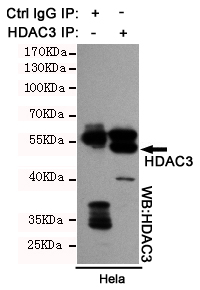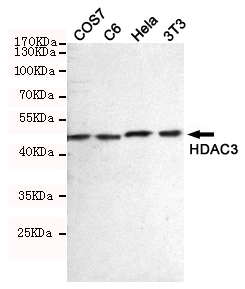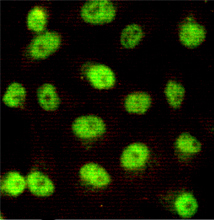-
Product Name
Anti-HDAC3 (7G6) Mouse antibody
- Documents
-
Description
HDAC3 (7G6) Mouse monoclonal antibody
-
Tested applications
WB, ICC/IF, IP
-
Species reactivity
Human
-
Isotype
Mouse IgG2a
-
Preparation
Antigen: Purified recombinant fragment of human HDAC3 (aa224-428) expressed in E. Coli.
-
Clonality
Monoclonal
-
Formulation
Ascitic fluid containing 0.03% sodium azide.
-
Storage instructions
Store at 4°C short term. Store at -20°C long term. Avoid freeze / thaw cycle.
-
Applications
WB: 1/500 - 1/2000
ICC: 1/200 - 1/1000
ELISA: 1/10000
-
Validations

Immunoprecipitation analysis of Hela cell lysates using HDAC3 mouse mAb.

Western blot detection of HDAC3 in COS7,C6,Hela and 3T3 cell lysates using HDAC3 mouse mAb (dilution 1:500).Predicted band size:48.8KDa.Observed band size:48.8KDa.

Immunocytochemistry of HeLa cells using HDAC3 mouse mAb (dilution 1:100).
-
Background
Swiss-Prot Acc.O15379.HDAC3: histone deacetylase 3, also known as HD3, RPD3, RPD3-2. Entrez Protein NC_000005. Histones play a critical role in transcriptional regulation, cell cycle progression, and developmental events. Histone acetylation/deacetylation alters chromosome structure and affects transcription factor access to DNA. The protein encoded by this gene belongs to the histone deacetylase/acuc/apha family. It has histone deacetylase activity and represses transcription when tethered to a promoter. It may participate in the regulation of transcription through its binding with the zinc-finger transcription factor YY1. This protein can also down-regulate p53 function and thus modulate cell growth and apoptosis. This gene is regarded as a potential tumor suppressor gene.
Related Products / Services
Please note: All products are "FOR RESEARCH USE ONLY AND ARE NOT INTENDED FOR DIAGNOSTIC OR THERAPEUTIC USE"
